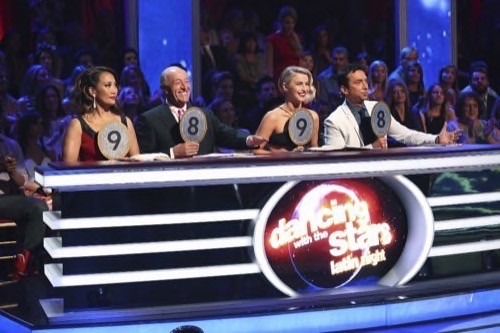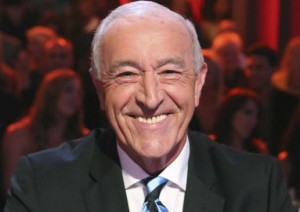Dancing With the Stars is in its 20th season, and is celebrating its 10th anniversary of airing on television (it airs in spring and fall). For a show that’s practically ancient by reality television standards, it is still delivering some surprisingly big numbers in the ratings.
Its March season premiere brought in 14 million viewers and won that Monday night, and that is coming off a fall season that had its highest finale numbers in four years. The show, which featured dances from Disney movies last night, still ranks in the top 10 (except for the weeks with sporting events like NCAA Basketball).
That all sounds impressive, but those big numbers don’t tell the whole story. Fourteen million people watched the premiere, but the show dropped 17 percent from it’s fall 2014 season premiere in the key 18-49 demographic, to a 2.0 rating. (A single ratings point represents 1.15 million households.) DWTS is a show that skews older, which isn’t appealing at all for advertisers.
DWTS shares a time slot on ABC with The Bachelor, another big reality franchise show. It is also losing viewers. Its most recent season-ending show sank to a finale low, and had a smaller overall audience — 9.5 million for the main show, and 9.7 million for the After the Final Rose special.
But The Bachelor earned a 2.6/2.7 rating in that key demo. While younger viewers are also disappearing, more are turning in for the The Bachelor than on Mondays when DWTS air.
And, both ABC shows are getting hammered on Monday nights by NBC’s The Voice, which rules in that key demo, earning a 4.1 rating in key demos for its March 2015 premiere, and a 3.3 rating against DWTS’s season premiere.
Dancing has tried over the past few years to make some alterations in order to fix its diminishing ratings, but so far it hasn’t helped significantly. The show switched up the format in Season 16, axing its Tuesday night results show. It hired Fox Sports anchor Erin Andrews, a former DWTS contestant, as a co-host.
It’s also tried to appeal to younger audiences by bringing on young people from “hot” franchises, including this season’s contestant 14-year-old Hunger Games star Willow Shields. It has even added a younger face to the judging panel in Season 19 (after a string of guest judges). The producers wisely selected 26-year-old Julianne Hough, who was a former professional dancer on the show, and arguably the most famous pro the show has produced.
After leaving the show in 2008, she made a country music album (and took home Top New Artist and Top New Female Vocalist at the 2009 Academy of Country Music Awards), and has starred in movies like Rock of Ages, Burlesque, the Nicholas Sparks film Safe Haven and the Footloose remake. She also famously dated Ryan Seacrest for a while.
Now she is back on the show, but behind the judging desk. She’s definitely beautiful and often times critical, but like the other judges, fairly predictable.
After 20 seasons, predictability is really the biggest issue this show faces. It has the same judges (sans a few guests and the aforementioned Hough) who give similar critiques week after week.
Viewers know that Bruno Tonioli will be over-the-top, that Carrie Ann Inaba will be watching for lifts and weeping a lot, and that Len Goodman will be highly critical of footwork and form. In the day and age of the DVR, that makes their commentary somewhat unnecessary, when you can skip ahead to the scoring.
Even though the stars change from season to season, the show does seem to follow a similar casting rubric that adds to the sameness from season to season.
There will likely be a professional male athlete (usually football or basketball) and female athlete (usually a gymnast or skater), an ’80s or ’90s TV star with nostalgia factor, someone a little goofy, a gorgeous supermodel type, a Disney channel star that only those with kids under 13 will recognize, and a former Bachelor/Bachelorette.
Younger audiences are likely to only tune in if they are really passionate about a certain star, or watch one week out of curiosity.
Although Goodman has plenty to gripe about, the quality of dancing is a lot better now than it used to be. That may sound like a good thing, but as audience expectations for the “perfect” and high scores is increased, the pros and stars have upped their games.
This means that the frontrunners come out of the gate strong, and stay strong the entire season, and that after a few weeks they practically look like pros (take a look at Rumer Willis and Nastia Liukin this season). And with that high quality, and little chance of an upset, it is dull to watch.
But it isn’t just Dancing that is suffering. A lot of long-running reality staples are starting to dwindle in the ratings, while still bringing in enough loyal viewers to stay on the air.
Survivor in its peak early few seasons brought in an average of well over 20 million viewers. Now that it is currently running its 30th season, that average number is a lot closer to 10 million. Earlier this year we looked at the plight of American Idol, which has slipped from its stronghold over the years.
With a premiere that attracted 14 million viewers it is unlikely that DWTS will be canceled any time soon, but the show certainly needs to find some way to bring in more of those advertiser friendly viewers in order to stay relevant for another decade.
For story ideas, check the ratings for DTWS and other reality shows in your market. Is there anyone with a local connection on the show? Any advertisers particularly loyal to the programs?
STORY IDEAS
How the Voice Succeeds Without a Breakout Winner
Idol vs. Survivor: Ratings Fight
Julianne Hough on Joining the Judges Panel











